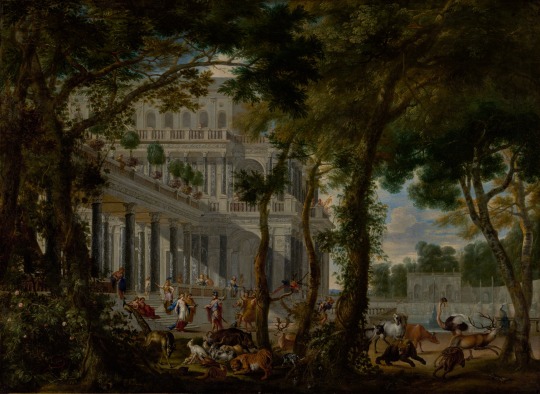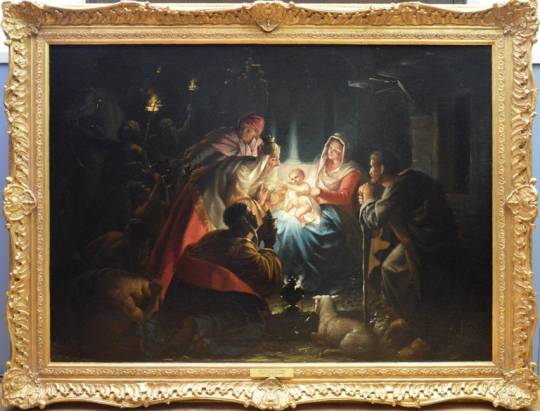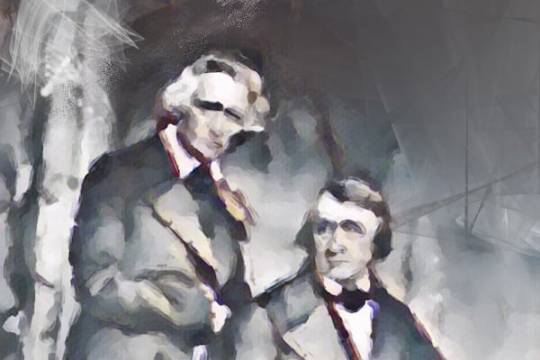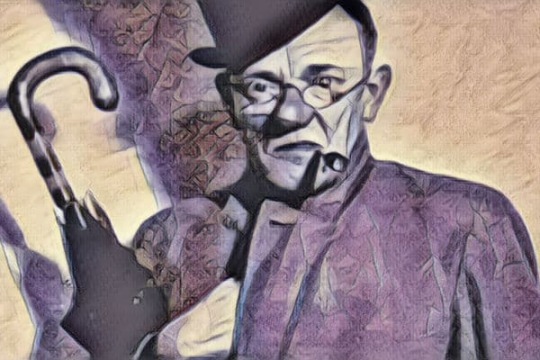#Carl Ehrenberg
Explore tagged Tumblr posts
Text

Thor battling giants, Carl Ehrenberg
43 notes
·
View notes
Text

« Les rois de la terre sont des hommes puissants, Et les villes sont brûlées pour leur plaisir, Et les cieux pleuvent la mort dans la nuit silencieuse, Et les collines crachent la mort toute la journée !
Mais le Roi du Ciel, Qui les a tous créés, Est belle et douce, et très petite ; Il se couche dans la paille, près de l'étable des bœufs — Qu'ils pensent à lui aujourd'hui !
~Joyce Kilmer
(Art : L'Adoration des Mages de Carl Ehrenberg, 19e siècle)
2 notes
·
View notes
Text

Ulysses at Circe's Palace by Wilhelm Schubert van Ehrenberg and Carl Borromäus Andreas Ruthart
#wilhelm schubert van ehrenberg#carl borromäus andreas ruthart#art#ulysses#odysseus#circe#palace#the odyssey#sorceress#witch#stairs#architecture#magic potion#animals#wild beasts#antlers#wild boar#classical antiquity#greek mythology#homer#ancient greece#ancient greek#europe#european#trees#herbal antidote#hermes#landscape#flemish#gardens
179 notes
·
View notes
Photo

“The Kings of the earth are men of might, And cities are burned for their delight, And the skies rain death in the silent night, And the hills belch death all day!
But the King of Heaven, Who made them all, Is fair and gentle, and very small; He lies in the straw, by the oxen’s stall — Let them think of Him to-day!”
~Joyce Kilmer
(Art: The Adoration of the Magi by Carl Ehrenberg, 19th century)
#Nativity#Christian art#Christmas#King of Heaven#King of Kings#Creator#pantocrator#Joyce Kilmer#Poetry#The Adoration of the Magi#Carl Ehrenberg#Lord Jesus#Christ Child#poets
29 notes
·
View notes
Photo


Carl Ehrenberg (1840-1914), 'The Norns', from ''Myths of the Norsemen from the Eddas and Sagas'' by Hélène Adeline Guerber, 1909 Source: https://archive.org/details/mythsofthenorsem00gueruoft
#carl ehrenberg#german artist#h.a guerber#hélène adeline guerber#myths of the norsemen from the eddas and sagas#norse myth#norse mythology#the norns#the three fates
59 notes
·
View notes
Text
5 steps to becoming a smarter target marketer - Bizcommunity.com
5 steps to becoming a smarter target marketer – Bizcommunity.com
Dr Carl Driesener, senior marketing scientist at the Ehrenberg-Bass Institute (EBI) of marketing science in Australia – the home of evidence-based marketing, shared five steps to being a smarter target marketer at Spark Media’s recent ‘seminar roadshow’.
<noscript class="j-lazy-noscript" data-lazyid="img-c-525266-16fe0d26-2df2-4e6d-875b-44f61e00642a" data-lazyimg="” data-lazyauto=”true”>
Dr…
View On WordPress
1 note
·
View note
Photo

Wilhelm Schubert van Ehrenberg & Carl Borromäus Andreas Ruthart - Ulysses at the Palace of Circe [1667]
1 note
·
View note
Text
A real stable genius Thomas Mann
Society struggles to recognize a genius like Thomas Mann. Prejudice, politics and the human fear in front of the unknown. Phenomenal people with great minds and new ideas come in all generations. Thomas Mann is surely one of that kind. German's past generations count many famous writers, storytellers, and novelists. Friedrich Schiller, E.T.A Hoffman, Gunter Grass, and Johann Wolfgang von Goethe are just some of them. Their works are unforgettable. Where I am, there is Germany. I carry my German culture in meThomas Mann answers to reporters in New York in February 1938 Thomas Mann, a German short story writer, essayist, philanthropist, and novelist too. His influence survived the oppression of the Nazi-regime. He never truly stopped living among the German nation, wherever he was.
Thomas Mann's beginning and family
The father, Thomas Johann Heinrich Mann was a senator and a grain merchant. His mother, Julia da Silva-Bruhns, was Brazilian women of Portuguese and German provenance. He was born in Lubeck, Germany, a traditionally protestant region. His mother was a Roman Catholic. Although he was baptized into his father's Lutheran religion. What will bring Thomas to Munich? Unfortunately, the death of his father in 1891 is one of the main reasons why that happened. His father's trading company came to its end after this tragic event. And because of that, a whole family moved to Munich. Destiny is a nonwritten path and maybe this was something necessary on his road becoming a writer. This extravagant man's works caught the interests even in the world of psychology and the human intellect. This noticeable since his day one as a writer. His novellas and epic novels with an ironic tone are well-known among actual writers and academic careers. His heritage will accompany literature for many generations. Part of this heritage is surely his analyzes and critiques about the German and European souls in general. Typical for his late works are the dogmatical and mythological subjects. He is famous for his position about the ideas of popular writers. Some of them are Johann Wolfgang von Goethe, Friedrich Nietzsche, and Artur Schopenhauer. His first novel Buddenbrooks portrays his class and family. What I must not forget to mention is that he was a member of the Hanseatic Mann family. The family Mann had truly notorious as writers. His older brother, for example, called Heinrich Mann is also well-known as a writer. One interesting aspect is that Thomas Mann was the father of 6 children. Three of them, Erika Mann, Klaus Mann, and Golo Mann became significant German writers too.
Thomas Mann's school days
Thomas Mann started his school days in Lübeck. Like Einstein, his teachers misinterpreted his geniality. He declared many times how he disliked the school years. His eclectic interests after school inspired him to new areas of interest. After that, he managed to attend the Ludwig Maximillian's University of Munich. His presence at the Technical University of Munich prepared him for his journalism career. He was studying economics, history, art history, and literature here. Later on, Thomas has been working at the South German Fire Insurance Company in 1894-95. And soon after, his first short book will get to its shining. In the year of 1898, he publishes 'Little Mr. Friedemann'. Seven years later, Thomas Mann married Katia Pringsheim. He had a major personal conflict with the raise from Hitler to power. He fleed to Switzerland for many reasons. One of these was the family his wife, who was partially jews. After that, he moved to the USA because World Warr II started but returned to Switzerland in 1952.
A value of the Buddenbrooks novel
This first novel by Thomas Mann had a big significance in German and international literature. Thomas Mann publishes this book in 1901 when he was twenty-six years old. This book is being marked as a success after its second edition publication two years after. For English language readers, it became available in 1924 when the book got translated by Helen Tracy Lowe-Porter. Thomas Mann started to write it in 1897 and published in 1901. In this book, he describes his point of view from society and conflicts in a new environment. Partially can be understood as the conflicts between the artist's worlds and businessman. The biggest success of this book is not its two editions, of course. With this book, Thomas Mann will be nominated for the Nobel Prize in Literature in 1929. This is the highest-ranked award that can be given to any writer. Buddenbrooks is certainly Thomas Mann's most popular novel and it will remain that forever. In Germany, it is valued for its intimate portrait of 19th-century German bourgeois life.
Thomas Mann's homosexuality
One of his central concerns was to accept and live with is his homosexuality. Although he concluded a marriage and got children, that couldn't cover his true nature. We can find the first signs of his homosexuality in Anthony Heilbut's biography. He uncovered his nature and his feelings about the same gender. Sources in his works There is an anecdote about Thomas reacting to the angelic figure of the Polish ten years boy. Also, his personal diary can give us some conclusions too. Based on the affirmations in those, is easy to understand his attraction for his own son. Especially when Klaus Mann was thirteen years old. He will keep writing about his attraction to his son in his diary though. It will not be the rare case when Thomas write some erotic compliments on his son's looking. In addition, there is a letter where Thomas Mann wrote to Carl Maria Weber about his feeling. He was constantly focused on Klaus's body and his appearance. It is known that Thomas Mann in younger years had feelings for his friend Paul Ehrenberg. This case will have an impact on his potential marriage with an English woman, Mary Smith, in 1901. It happened again to him in 1950. He met the nineteen years old waiter in Grand Hotel Dolder, Franz Westermeier. This young man brought him to some depressive moments. Thomas Mann compared himself to Michelangelo in the Renaissance in the poetry about Tomasso Cavalieri. He denied that his novels ever had autobiographical components but he unsealing of his diaries speaks for itself. That will be enough to convince everyone in his true nature.
Style of his writing
Every classic writer has a recognizable style of writing. Like the singers that are recognizable for their tone of the voice. Thomas Mann's writing style contains a remarkable amount of irony and satire, but humor too. His style will gain its final form after the completion of his work 'Buddenbrooks'. On one level there is a deep and meaningful approach. On the other are even deeper levels of representation. That's how the author will write throughout his whole career. His writing is honored all around the world. Not only in Germany. And that can be convincing enough about his writing style. He will remain acknowledged as one of the most renowned and greatest writers of the 20th century. His life ended in a tragic way. He fought with tuberculosis was long and predictable. He died on the 12th of August in 1955 in Zurich. Kilchberg is the place where he got buried.
Related Articles

Brothers Grimm in Bavaria

Karl Valentin a eternal genius

Walking Tour - Third Gender in Bavaria Read the full article
1 note
·
View note
Photo






Circe, depicted on a Sicilian altar (c. 525 bc)
Brewer's 1892 Circe and Her Swine
Pintura de 1667, obra de Wilhelm Schubert van Ehrenberg (1630 o 1637 - ca. 1676): Odiseo en el palacio de Circe. Las figuras de animales fueron añadidas por Carl Borromäus Andreas Ruthart (1630 - 1703).
Circe (en griego Κίρκη) era una diosa y hechicera que vivió en la isla de Eea.1
Sus padres fueron Helios, el titán preolímpico del Sol, y la oceánide Perseis. Como hermanos tuvo a Eetes y Pasífae.
Circe transformaba en animales a sus enemigos y a los que la ofendían mediante el empleo de pociones mágicas y era famosa por sus conocimientos de brujería, herborística y medicina.
En la Odisea de Homero, el palacio de Circe es descrito como una mansión de piedra que se alzaba en el centro de la isla de Eea, en medio de un valle y un claro en un denso bosque. Alrededor del referido palacio, rondaban leones y lobos, que en realidad no eran más que las víctimas de su magia: no eran peligrosos y lisonjeaban a todos los extraños. Circe dedicaba su tiempo a trabajar en un gran telar.
1 note
·
View note
Text
April 05 in Music History
1595 Birth of composer John Wilson.
1698 Birth of composer Georg Gottfried Wagner.
1705 Grand opening of Queens Theatre with the first Italian opera in London, Greber: Gli amori d'Ergasrto.
1727 Birth of Italian composer Pasquale Anfossi.
1752 Birth of French piano and harp manufacturer Sebastian Erard.
1779 FP of Gazzaniga´s "Il disertore" Florence.
1784 Birth of German violinist and composer Louis Spohr in Brunswick.
1798 Birth of American piano manufacturer Jonas Chickering.
1799 Birth of composer Vincenzo Fioravanti.
1803 FP of Beethoven's Piano Concerto No. 3 and Symphony No. 2 at a benefit concert in Vienna.
1824 Death of Italian bass Francesco Benucci.
1828 Birth of composer Pietro Platania.
1839 Birth of composer Stanislaw Pilinski.
1853 Birth of composer Alfonso Randano.
1854 Birth of composer Vicente Goicoechea Errasti.
1859 Birth of composer Wilhelm Harteveld.
1862 Birth of composer Louis Ganne.
1866 Death of soprano Louise-Therese Lemonnier.
1869 Birth of French composer Albert Roussel in Tourcoing, France.
1870 Birth of German baritone Hermann Gura in Breslau.
1874 FP of Die Fledermaus by Johann Strauss Jr. in Vienna.
1876 Birth of Swedish composer, organist Viktor Patrik Vretblad.
1878 Birth of composer Carl Emil Theodor Ehrenberg.
1882 Birth of English tenor Joseph Hislop in Edinburgh.
1885 Birth of composer Dimitrie Cuclin.
1892 Birth of bass Rudolf Watzke in Niemes.
1898 Birth of soprano Edytha Fleischer in Falkenstein.
1902 FP of Ravel's Pavanne for a Dead Princess. Ricardo Viñes, pianist, in Paris.
1903 Birth of composer Thomas Baron Pitfield.
1905 Birth of composer Jef Maes.
1906 Birth of Italian organist Fernando Germani.
1908 Birth of Austrian conductor Herbert von Karajan in Salzburg.
1911 Birth of English-born American recording executive Goddard Lieberson.
1917 Birth of American composer Richard Yardumian in Philadelphia.
1921 Death of Dutch composer Alfons Diepenbrock.
1922 Birth of composer Harry Freedman.
1924 Birth of Italian soprano Onelia Fineschi in Florence.
1925 Birth of American bass Keith Engen in Frazee, Minnesota.
1925 Birth of composer Oldrich Flosman.
1927 Birth of bass-baritone James Milligan in Halifax Nova Scotia.
1928 Birth of composer David Farquhar Andress.
1932 Birth of American soprano Mary Costa in Knoxville.
1933 Birth of Swiss soprano Eugenia Ratti.
1936 Birth of English composer John White in Berlin.
1946 FP of Samuel Barber's Cello Concerto.
1948 Birth of Italian tenor Dano Raffanti.
1949 Birth of Dutch mezzo-soprano Marion Lambrinks.
1949 FP of Roy Harris's symphonic scherzo Kentucky Spring.
1959 Birth of English pianist Julius Drake.
1961 Birth of Italian soprano Anna Caterina Antonacci in Ferrara.
1967 Death of Russian violinist Mischa Elman.
1969 Death of Russian soprano Andrjeva von Skilondz.
1974 Death of English soprano Jennifer Vyvyan.
3 notes
·
View notes
Text
Hyperallergic: Art Movements
John Singer Sargent, “Gassed” (1919), oil on canvas, 90 1/2 x 240 in (courtesy Imperial War Museums, London; photo © IWM Imperial War Museums)
Art Movements is a weekly collection of news, developments, and stirrings in the art world. Subscribe to receive these posts as a weekly newsletter.
The New York Historical Society will display John Singer Sargent’s monumental painting “Gassed” (1919) as part of its exhibition, World War I Beyond the Trenches. It is the first time the work has ever been displayed in New York.
New York Attorney General Eric Schneiderman announced that the Gagosian Gallery agreed to a $4.28 million settlement for failing to pay taxes on art sales.
The Prague State Attorney’s Office issued an arrest warrant for Oleg Vorotnikov. According to the Prague Monitor, Czech police are searching for the Russian dissident artist after he “violated” court commitments. A member of Voina, Vorotnikov is best known for painting a giant penis on a drawbridge opposite Russia’s secret service headquarters in Saint Petersburg.
The Übersee-Museum Bremen in Germany returned its collection of ancient Moriori and Maori remains to New Zealand.
The Labour Party pledged £1 billion (~$1.29 billion) to the arts over a five year period as part of their election manifesto. The UK general election will take place on June 8.
A 14-year-old boy was charged with third-degree arson for allegedly igniting a massive fire that destroyed New York’s historical Beth Hamedrash Hagodol synagogue. It took around 140 firefighters to quell the blaze, two of whom were treated for minor injuries. The synagogue, which has been vacant since 2007, was granted landmark status in 1967.
National Museums Scotland launched an international fundraising campaign to acquire the Galloway Viking Hoard. Metal detectorist Derek McLennan, who found the Hoard in September 2014, stands to receive a £2 million (~$2.59 million) reward after alerting experts to his discovery.
The New York City Landmarks Preservation Commission approved a proposal by Xinyuan Real Estate to built a 16-floor condo tower on the site of Thomas W. Lamb’s RKO Keith’s Theater in Queens.
The Coney Island History Project identified the creator of the iconic Spook-A-Rama Cyclops. The model, which has been on a national tour since 2014, was designed by Coney Islander and billboard painter Dan Casola (1902–1990).
Transactions
Egon Schiele, “Danaë” (1909), oil and metallic paint on canvas, 31 5/8 x 49 3/8 in (courtesy Sotheby’s)
Sotheby’s withdrew the star lot of its Impressionist and modern art evening sale, Egon Schiele’s “Danaë” (1909), at the last minute. The painting was estimated to sell for between $30–40 million. The Sotheby’s evening sale went on to fetch $173.8 million, far below the $289.1 million that Christie’s raised at theirs. The post-war and contemporary evening sale at Christie’s fetched a total of $448.1 million.
Sotheby’s inaugural modern and contemporary African Art sale totaled £2.8 million (~$3.6 million).
The Cincinnati Art Museum received a $11.75 million bequest from Carl and Alice Bimel. The gift will be used to establish the Alice Bimel Endowment for Asian Art, which will expand the museum’s collection of art from South Asia, Iran, and Afghanistan.
Documentary photographer David Hurn donated 1,500 of his own photographs and 700 photographs from his private collection to Amgueddfa Cymru, National Museum Wales.
The John S. and James L. Knight Foundation will provide $1.87 million to 12 art museums for the purpose of engaging visitors with new technologies.
A first edition of George Cruikshank’s “The Scourge” (1811–16) sold at Swann Auction Galleries for $11,250 — a record for the work.
George Cruikshank “The Scourge” (1811–16), 12 volumes, illustrated with 77 hand-colored engraved and etched plates (courtesy Swann Auction Galleries)
Transitions
French president Emmanuel Macron appointed Françoise Nyssen as France’s new Minister of Culture.
Luis A. Croquer was appointed director of the Rose Art Museum.
Shawn Brixey was appointed dean of Virginia Commonwealth University’s School of the Arts.
Jane South was appointed chair of Pratt Institute’s fine arts department.
Katelyn D. Crawford was appointed curator of American art at the Birmingham Museum of Art.
Heidi Holder was appointed director of education at the Queens Museum.
Abby Bangser was appointed deputy director of strategic initiatives at the Dia Art Foundation.
The inaugural Bangkok Biennale will be held from November 2018 to February 2019.
Sanya Kantarovsky is now represented by Luhring Augustine. Josh Smith recently left the gallery’s stable.
Accolades
Hanuman leaps across the ocean, folio from the small Guler Ramayana series (approx 1720 India; Pahari region, Himachal Radesh), pigments and gold on paper, Museum Rietberg Zurich (photo © Rainer Wolfsberger, courtesy Asian Art Museum of San Francisco)
The Asian Art Museum of San Francisco received three awards for its 2016 exhibition, The Rama Epic: Hero, Heroine, Ally, Foe.
The jury of the 57th Venice Biennale announced the recipients of its Golden Lion Awards.
The Texas State Legislature appointed Sedrick Huckaby and Beili Liu as the State’s 2018 Two-Dimensional and Three-Dimensional Artists, respectively.
Anne Imhof and and Huey Copeland were awarded the 2017 Absolut Art Award in the artwork and art writing categories, respectively.
The Institute of Museum and Library Services announced the 10 recipients of its 2017 National Medal for Museum and Library Service.
The National Museum of Women in the Arts received a 2017 MUSE Award for its social media campaign “Can You Name #5WomenArtists? A Viral Campaign for Women’s History Month.”
Obituaries
A selection of works by Felipe Ehrenberg (courtesy Freijo Gallery)
Chris Cornell (1964–2017), musician, singer, and songwriter. Member of Soundgarden and Audioslave.
Lloyd Cotsen (1929–2017), collector.
Chuck Davis (1937–2017), dancer and choreographer.
Felipe Ehrenberg (1943–2017), conceptual artist.
Jean Fritz (1915–2017), writer and children’s author.
Lee Hall (1934–2017), painter. Author of Elaine and Bill: Portrait of a Marriage (1993).
Luis Miret (1959–2017), dealer and curator. Director of Galería Habana.
Judith Stein (1940–2017), historian and author. Best known for The World of Marcus Garvey: Race and Class in Modern Society (1986).
Beatrice Susa (1981–2017), co-founder of the Arte Laguna Prize.
The post Art Movements appeared first on Hyperallergic.
from Hyperallergic http://ift.tt/2qAgZhi via IFTTT
0 notes
Photo

Carl Ehrenberg [a.k.a. Gottfried Ferdinand Carl Ehrenberg; Karl Ehrenberg](German, 1840 - 1914), Self Portrait, 1906, pastel 65 x 50 cm.
4 notes
·
View notes
Photo

Wilhelm Schubert van Ehrenberg (1630-1676) animals by Carl Borromäus Andreas Ruthart (1630-1703), 'Ulysses at the Palace of Circe', 1667
#wilhelm schubert van ehrenberg#carl borromäus andreas ruthart#ulysses at the palace of circe#circe#ulysses#flemish artists#flemish painters#german artists#german painters
29 notes
·
View notes